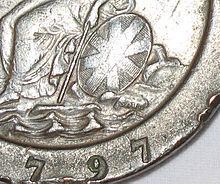Founder Matthew Boulton | Founded 1788 | |
 | ||
Soho Mint was created by Matthew Boulton in 1788 in his Soho Manufactory (grid reference SP051890) in Handsworth, West Midlands, England. A mint was erected at the manufactory containing eight machines, to his own patent design, driven by steam engine, each capable of striking 70 to 84 coins per minute.
Contents
In addition to copper domestic coins, silver coins were made for some of the colonies, and various medals and trade tokens were struck.
After the demise of the Soho Mint some of the machinery was bought at auction, in 1850, by the new Birmingham Mint of Ralph Heaton II.
Soho mint
Cartwheel penny
The common coinage, copper halfpennies, was subject to severe counterfeiting. No copper coinage had been issued by the Royal Mint since 1754 apart from inadequate issues of halfpence and farthings from 1770-75.
In order to differentiate his proposed copper coins from counterfeits Boulton specified them as follows:
Their weight in pure copper should be so close to the intrinsic value of the material that counterfeiting would be uneconomic. The diameter was made strictly defined by striking within a collar so that diameter, thickness and weight could be used to prove the quality of the metal.
In 1797 the first, and only, copper twopenny and the first penny coins were produced under contract although the smaller denominations did not follow until later. These coins were comparatively large, having a broad raised rim with the inscription pressed below the surface and became known as the cartwheel pennies. Over 45 million were minted in two years.
